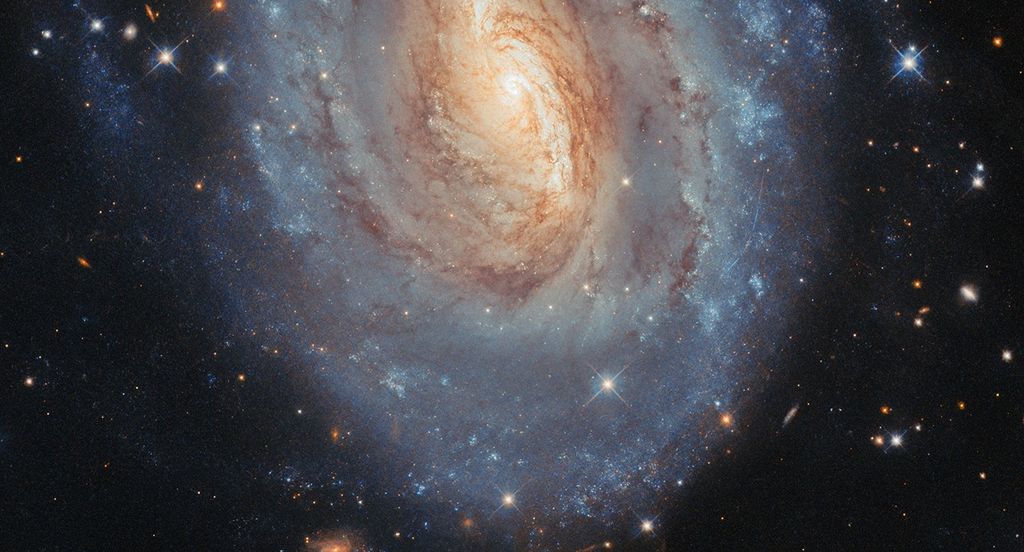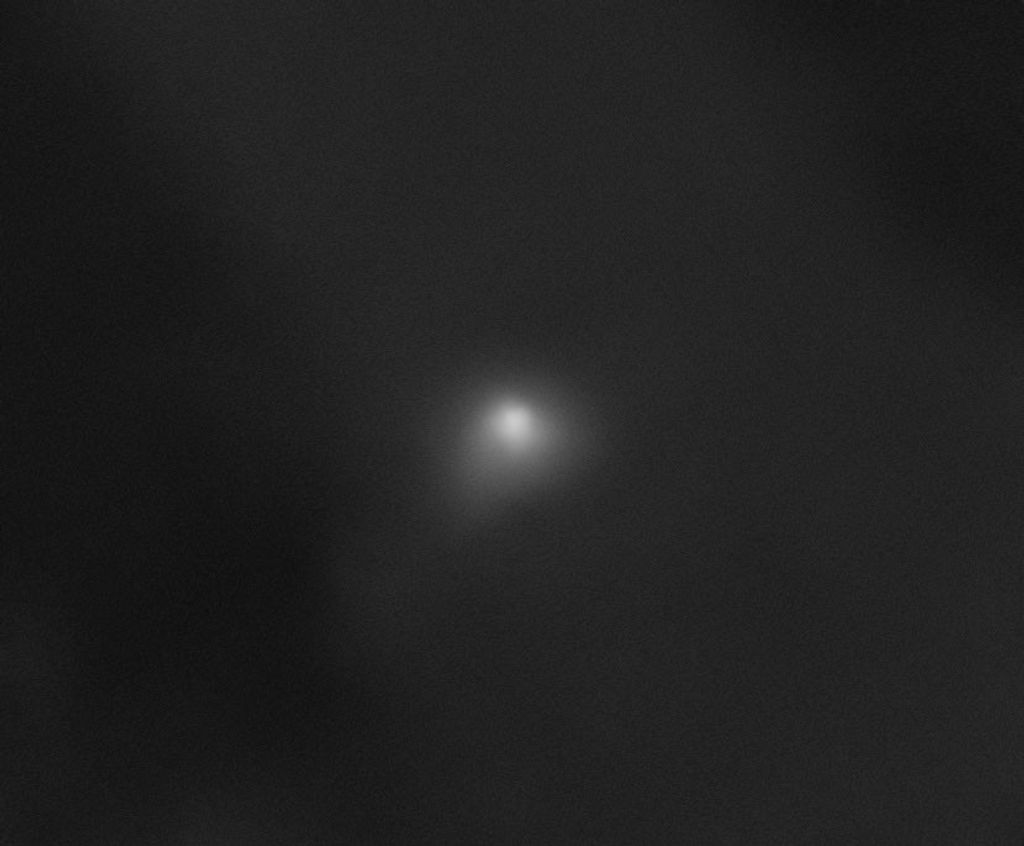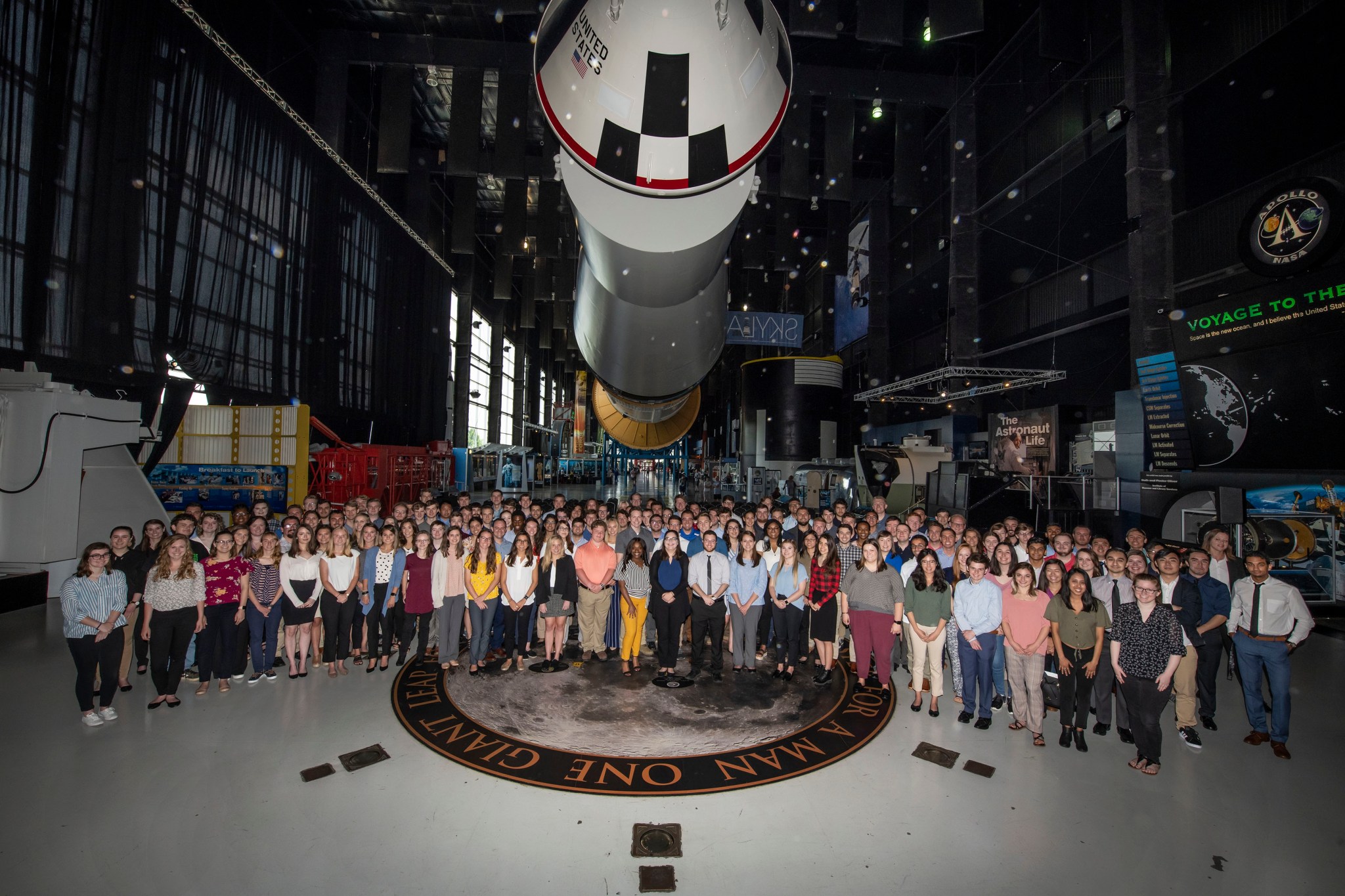In This Week’s Star
- NASA Deputy Administrator James Morhard Views SLS Progress
- Redstone Scientific Information Center to Close Doors, Operate Only Online
- Students, Marshall Both Benefit From Summer Internships
- ‘Pass the Torch’ Panels in July Help Tell the Story of Apollo
- FBI Section Chief Keri Farley Delivers Pride Month Address at Marshall
- Teams Build 3D-Printed Habitats for Moon and Mars
- Dragonfly Mission Highlighted on ‘This Week @NASA’
- This Week in NASA History: Pegasus C is Attached to S-IU-10 – July 6, 1965
NASA Deputy Administrator James Morhard Views SLS Progress
By Corinne Edmiston
NASA Deputy Administrator James Morhard visited NASA’s Michoud Assembly Facility for the first time June 28 to see the latest progress in manufacturing and assembling NASA’s Space Launch System.
Morhard, joined by Robert Champion, director of Michoud, and Paul McConnaughey, deputy director of NASA’s Marshall Space Flight Center, toured the facility and spoke to technicians and engineers assembling the core stage, including the recently integrated forward join and liquid hydrogen tank. The night prior to his official visit, Morhard toured the facility privately with Champion.
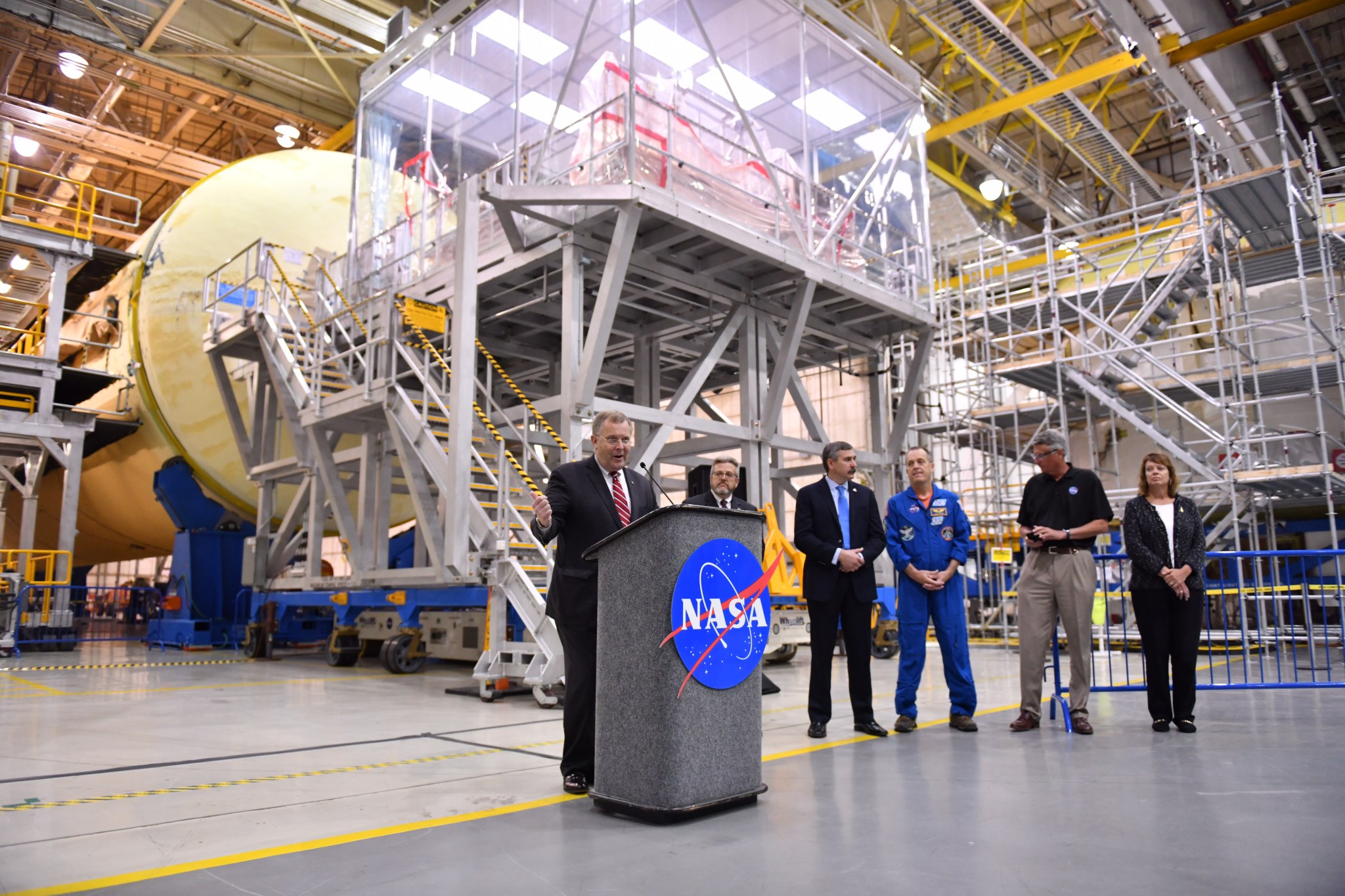
NASA is working to land the first woman and next man on the Moon by 2024. SLS is part of NASA’s backbone for deep space exploration, along with Orion and the Gateway in orbit around the Moon. SLS will be the most powerful rocket in the world and will send astronauts in the Orion spacecraft farther into space than ever before. No other rocket is capable of carrying astronauts in Orion around the Moon. Credits: NASA
“I came out here in the middle of the night and spoke to people who were working on the engine section,” Morhard said. “NASA is laser-focused on assembling this powerful rocket.”
Morhard’s tour came during a busy week at Michoud.
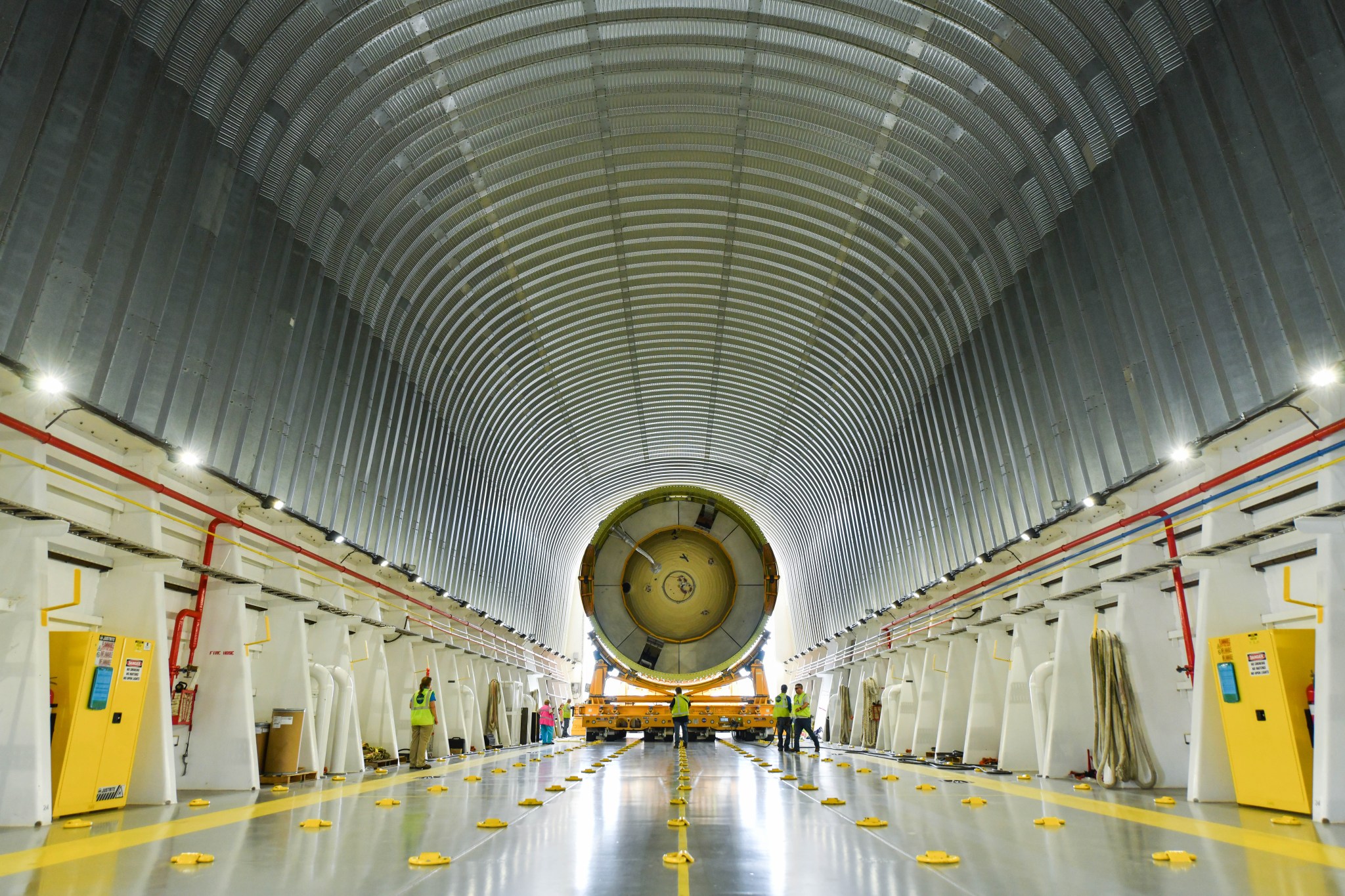
The SLS liquid oxygen tank structural test article, the last of four structural test articles for the rocket’s core stage, was loaded onto NASA’s Pegasus barge June 26 for delivery to Marshall. Structural testing on the nearly 70-foot-long test article will begin later this summer.
All four RS-25 engines for Artemis 1, the first flight of SLS and NASA’s Orion spacecraft, were delivered to Michoud from NASA’s Stennis Space Center. The engines were individually delivered by truck to the facility with the last shipment arriving June 27. Technicians from NASA and Aerojet Rocketdyne, the lead contractor for the engines, will prepare them for installation to the rest of the core stage later this summer.
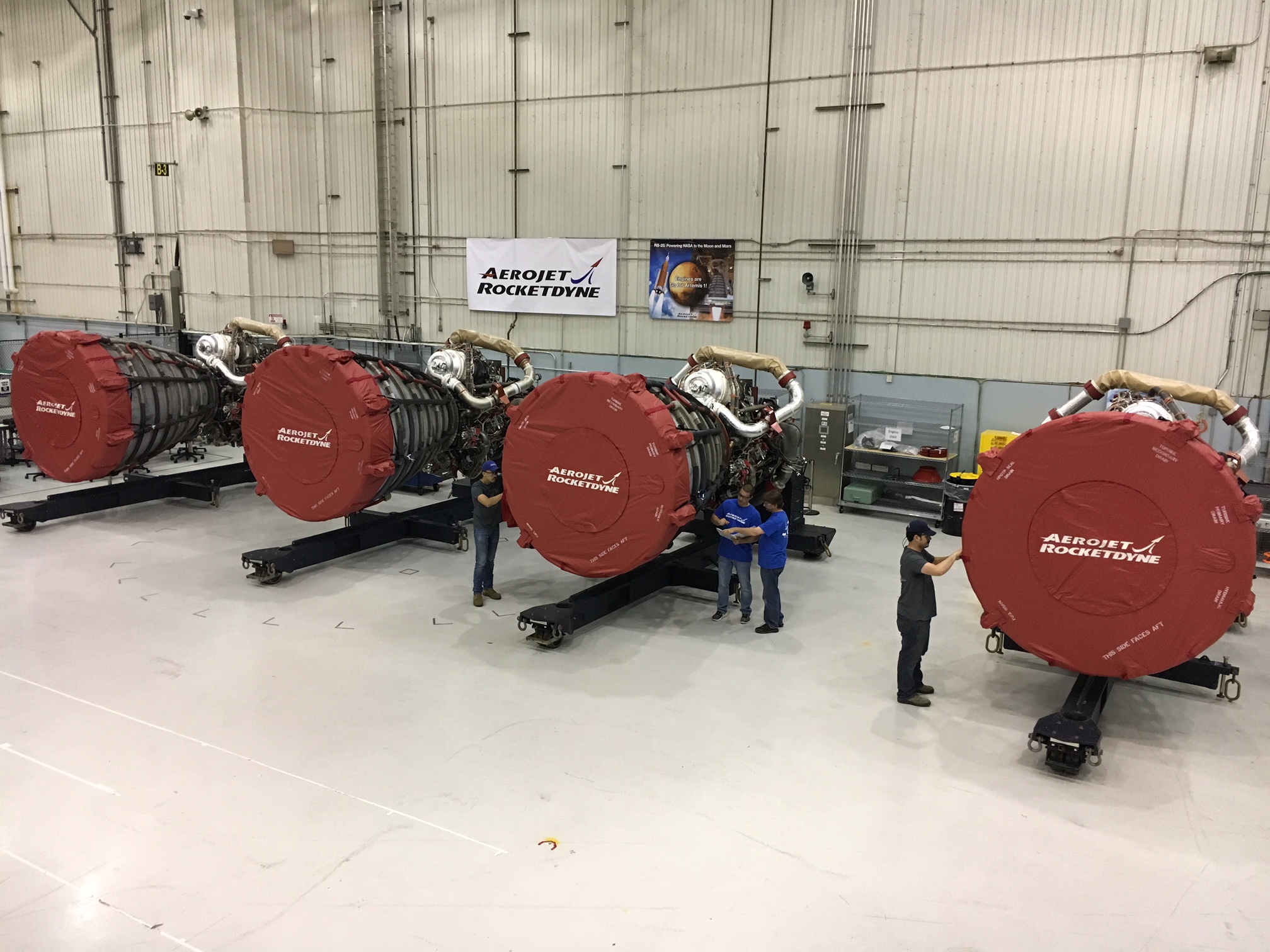
NASA is working to land the first woman and next man on the Moon by 2024. SLS is part of NASA’s backbone for deep space exploration, along with Orion and the Gateway in orbit around the Moon. SLS is the only rocket that can send Orion, astronauts and supplies to the Moon on a single mission. Credits: Aerojet Rocketdyne
Technicians will integrate the engine section and the four RS-25 engines to the rest of the stage later this summer. The stage remains on track for completion by December.
Edmiston, an ASRC Federal/Analytical Services employee, supports the Office of Strategic Analysis & Communications.
Redstone Scientific Information Center to Close Doors, Operate Only Online
By Daniel Boyette
Changes are coming to the Redstone Scientific Information Center.
The technical library will close its doors at the end of September and operate exclusively as an online entity beginning Oct. 1. NASA Marshall Space Flight Center employees will have access to online subscriptions through June 2020, at which time the agency will implement its own subscription source. Marshall is acquiring selected books and other documents from the RSIC and will make them available to employees once a location is selected.
“What we’re really interested in is what text books, journals and other items folks want moved to the new location,” said Ed Kiessling, Marshall’s logistics services manager. “If you are a user of the RSIC and you want any books transferred, now is the time to tell us.”
Requests can be made by emailing Kiessling (edward.h.kiessling@nasa.gov), Carolyn McMillan from the Technology Transfer Office (carolyn.e.mcmillan@nasa.gov), or librarian Mary Ellen Harris (mary.e.harris@nasa.gov).
The RSIC features books, journals and government technical reports, with an emphasis in aeronautics, aerospace, engineering and rocketry.
Boyette, an ASRC Federal/Analytical Services employee and Marshall Star editor, supports the Office of Strategic Analysis & Communications.
Students, Marshall Both Benefit From Summer Internships
By Brice Russ
More than 200 students — from high school to graduate school — are participating in internship programs this summer at NASA’s Marshall Space Flight Center. And what they’re learning will prove useful long after they leave.
In Marshall’s main summer internship program, college students work with mentors, frequently on a specific project, as part of a 10-week paid internship. More than 130 students, from college freshmen to doctoral candidates, are participating. They’re from 38 states and Puerto Rico, with fields of study as diverse as architecture, nuclear engineering and political science.
Joshua Ross, a rising senior at Brigham Young University in Provo, Utah, has been working on the Martian sample return framework for the Mars Ascent Vehicle. He said he appreciates the opportunity to build his skills in structural analysis while working on a project he feels is meaningful to advancing the mission of NASA.
“I’ve loved it all,” Ross said. “Being here, it’s been confirmed to me that I definitely am an engineer.”
Ali Bertelsman, a rising senior at the University of Kentucky in Lexington, is working on data displays for the Space Launch System propulsion system. Bringing her computer science background to a team of mechanical engineers has helped her appreciate how interdisciplinary engineering projects are. Bertelsman’s internship experience helped her decide to apply for graduate programs in aerospace engineering in the fall.
“It’s been an incredible opportunity,” she said, “and I hope that everyone else who chooses to come here has the same opportunity for growth that I did.”
Students who complete Marshall internships often then become interns in NASA’s Pathways program. Pathways internships, known as “co-ops” until 2012, offer students the opportunity to work as a civil servant at NASA for three non-consecutive semesters, with the potential for permanent or term employment after meeting program and academic requirements upon graduation. There are currently 73 Pathways interns at Marshall, with 53 working at the center this summer. Pathways interns are required to work in at least two organizations at Marshall, and as part of a new pilot program, some interns will have the opportunity to work at different NASA centers over the course of their internship.
For younger students interested in an introduction to NASA, Marshall’s Office of STEM Engagement offers a volunteer program for college students and high school students age 16 or older. Most of this summer’s 36 participants will work two days a week with a NASA mentor for four weeks. While most of this summer’s group is from the Huntsville area, some come from as far away as New York and Minnesota.
As valuable as students find these internships for building their skills and advancing their careers, the benefits for Marshall and NASA are possibly even greater.
“This program fills NASA’s attrition gap with brilliant young minds,” said Julie Clift, lead for the Pathways program at Marshall. “It helps us collaborate across both organizations and NASA centers to meet the evolving needs of our workforce.”
Or as Vicki Smith, coordinator of the student volunteer program of the Office of STEM Engagement, puts it, “This is our workforce pipeline.”
To learn more about NASA’s year-round internship opportunities:
- NASA internships: https://intern.nasa.gov/.
- Pathways internships: https://www.nasa.gov/careers/pathways-program.
- Office of STEM Engagement volunteer opportunities: Vicki Smith (vicki.a.smith@nasa.gov).
Russ, an ASRC Federal/Analytical Services employee, supports the Office of Strategic Analysis & Communications.
‘Pass the Torch’ Panels in July Help Tell the Story of Apollo
By Will Bryan
As NASA’s Marshall Space Flight Center celebrates the accomplishments of the Apollo program and prepares for future exploration, the center and the city of Huntsville are focused on sharing the experiences with a new generation.
“Pass the Torch Apollo Legacy Panels” are being held throughout the year. July topics include a discussion by children of the von Braun rocket team who chose careers in aerospace, and a discussion about the experiences and challenges in developing the engines for the Saturn rockets. Al Worden, the command module pilot for Apollo 15, will give a presentation on his historic mission that was the first to take the Marshall-developed lunar rover to the Moon.
Here are the scheduled July lectures:
July 11: Apollo Propulsion and Engines, 2:30 p.m., Discovery Theater, U.S. Space & Rocket Center
July 15: The Continuing Paperclip Legacy, noon, Discovery Theater, U.S. Space & Rocket Center
July 15: Al Worden Community Presentation, 2 p.m., National Geographic Theater, U.S. Space & Rocket Center
July 15: Saturn Family of Launch Vehicles, 3-5 p.m., National Geographic Theater, U.S. Space & Rocket Center
July 17: Onboard Control System for the German A4/V2 Rocket, noon, Discovery Theater, U.S. Space & Rocket Center
July 18: How We Really Got to the Moon: Leadership Secrets of the Apollo Program, 6 p.m., Huntsville-Madison County Public Library, downtown branch
July 20: Apollo 11 America’s First Landing on the Moon, 2:30 p.m., National Geographic Theater, U.S. Space & Rocket Center
July 25: How Apollo 8 Won the 1960s Space Race and Changed the World, 6-7 p.m., National Geographic Theater, U.S. Space & Rocket Center
All lectures are free and open to the public. For more information about the events at the U.S. Space & Rocket Center, visit here. For more information about the events at the library, visit here.
Bryan, an ASRC Federal/Analytical Services employee, supports the Office of Strategic Analysis & Communications.
FBI Section Chief Keri Farley Delivers Pride Month Address at Marshall
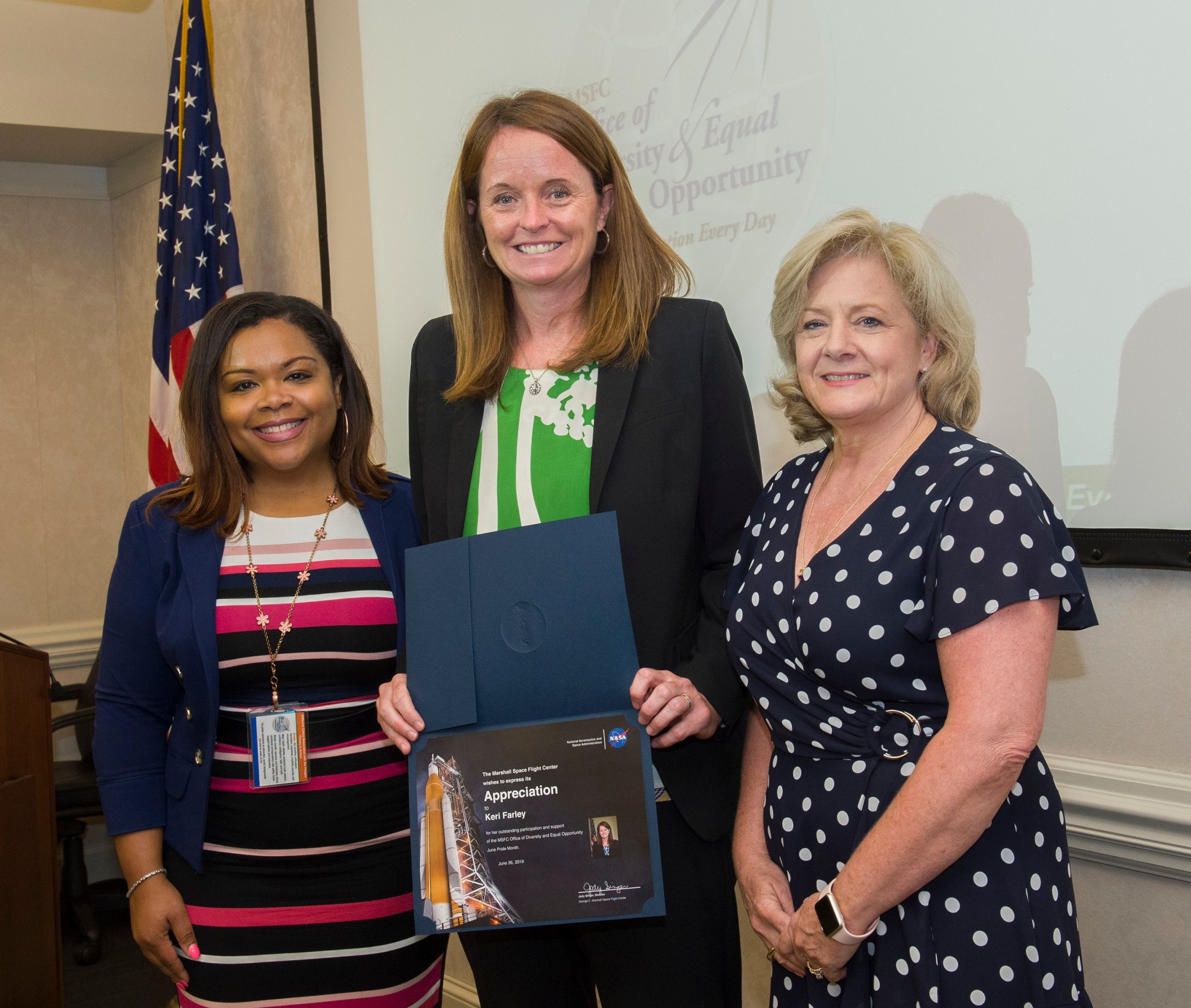
FBI Section Chief Keri Farley, center, leader of the agency’s Counterterrorism Internet Operations Section and “executive champion” for its diversity committee, receives a NASA certificate of appreciation June 26 from Jody Singer, right, director of NASA’s Marshall Space Flight Center, and Denise Smithers, deputy director of the Office of Diversity and Equal Opportunity. Farley’s address to Marshall team members concluded Marshall’s Pride Month observance, marking the 50th anniversary of the equal rights movement for lesbian, gay, bisexual, transgender and queer Americans. In her first address as the FBI’s diversity spokesperson, Farley said challenges still face LGBTQ career professionals, but stressed “the importance of authenticity, of being visible in the workplace” to encourage and inspire other LGBTQ employees. Singer hailed the work of Marshall’s Office of Diversity and Equal Opportunity “to honor the different groups of people who not only make this country great, but also make NASA great and enable us to achieve our mission.” Video of the event is available here. (NASA/Emmett Given)
Teams Build 3D-Printed Habitats for Moon and Mars
NASA challenged teams to 3D print habitats that could one day support astronauts on the Moon or Mars. Then they crushed them … for science, of course. See what happened when teams went head-to-head at the live competition. The 3D-Printed Habitat Challenge is managed through a partnership with NASA’s Centennial Challenges program and Bradley University in Peoria, Illinois. Centennial Challenges is managed at NASA’s Marshall Space Flight Center.
Dragonfly Mission Highlighted on ‘This Week @NASA’
NASA’s newly announced robotic mission to the Saturnian moon Titan is featured in “This Week @NASA,” a weekly video program broadcast nationwide on NASA-TV and posted online.
On June 27, NASA’s announced the next destination in the solar system for a robotic explorer is Saturn’s icy moon Titan — a unique organic world similar to early Earth. Named Dragonfly, the mission will fly, sample and examine sites around Titan to search for the building blocks of life. Dragonfly is expected to launch in 2026 and arrive in 2034. Once on Titan, it will fly to dozens of locations to study the chemistry and processes that could have led to life on Earth. Dragonfly is a mission of the New Frontiers program — managed at NASA’s Marshall Space Flight Center — that hosts robotic expeditions to Jupiter, Pluto and the asteroid Bennu.
View this and previous episodes at “This Week @NASA” on NASA’s YouTube page.
This Week in NASA History: Pegasus C is Attached to S-IU-10 – July 6, 1965
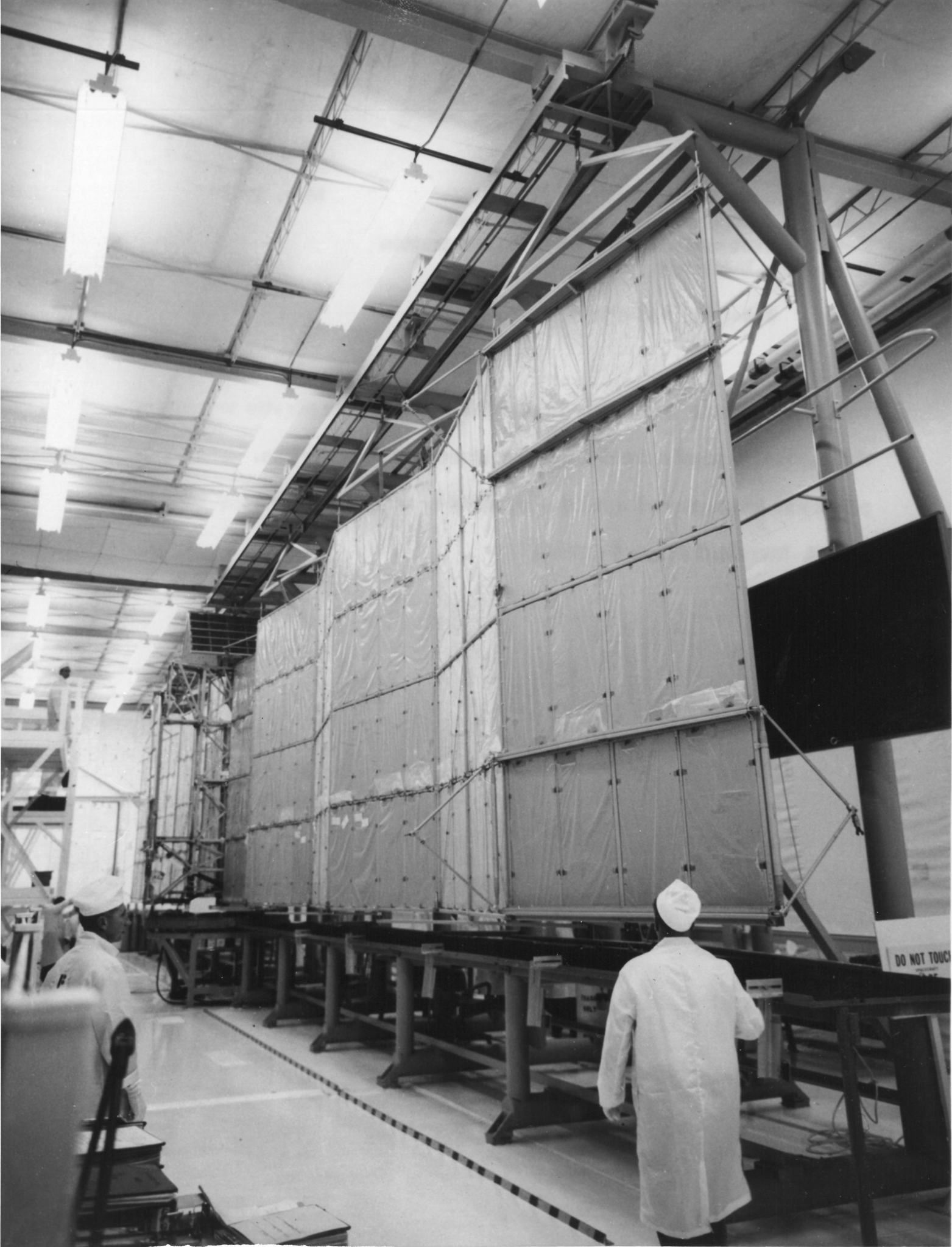
This week in 1965, technicians at NASA’s Kennedy Space Center attached the Pegasus C satellite to the SA-10 Instrument Unit, S-IU-10, following completion of premating systems checks and panel deployment checks. SA-10 was launched July 30, 1965, and was the final flight of the Saturn I rocket. Developed by Fairchild Stratos Corp. and managed by NASA’s Marshall Space Flight Center, Pegasus C was the last of three meteoroid detection satellites launched by NASA to electronically record the size and frequency of particles in space and compare the performance of protected and unprotected solar cells as an important preliminary to crewed flight to the Moon. Here, the Pegasus B satellite is wrapped in plastic to protect the capacitor panels from dust, moisture and fingerprints. The wrapping is not removed until the satellite is prepared for launch. This July, in a series of special events, NASA is marking the 50th anniversary of the Apollo Program — the historic effort that sent the first U.S. astronauts into orbit around the Moon in 1968, and landed a dozen astronauts on the lunar surface between 1969 and 1972. For more pictures, and to connect to NASA’s remarkable history, visit the Marshall History Program’s webpage. (NASA)

